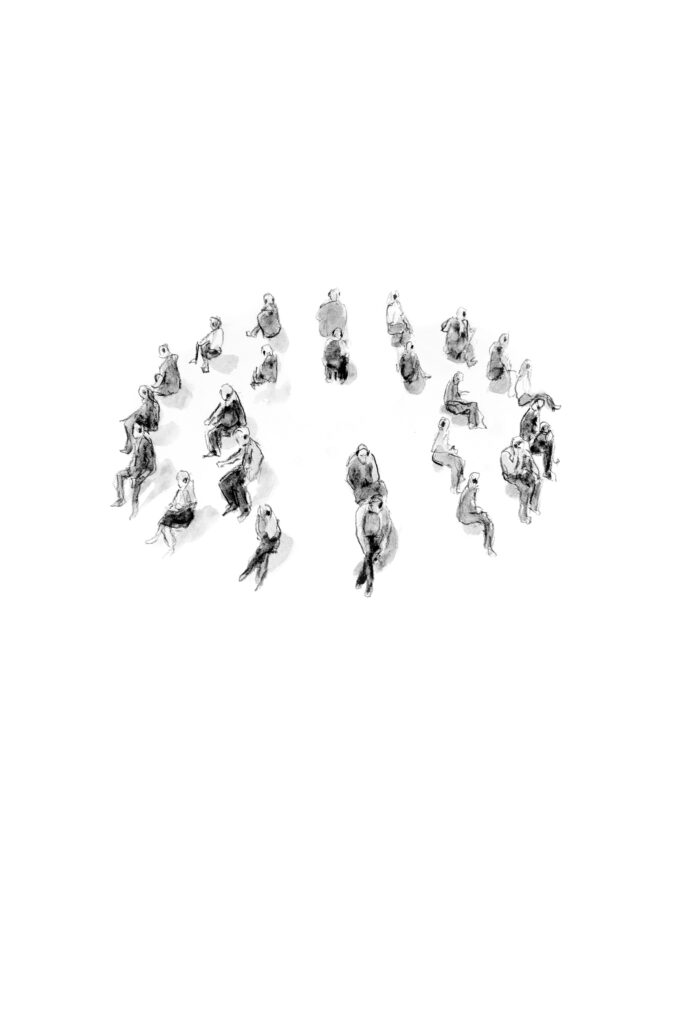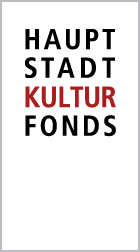
JAN-PETER E.R. SONNTAG MAISSCAPE- PROJECT PHASE#1: S_ ON AN IMMERSIVE INFRASONIC CONCERT INSTALLATION FOR A CIRCLE OF 24
TEMPELHOFER FELD, EINGANG ODERSTRASSE / HERRFURTHSTRASSE
SONNTAG, 24. SEPTEMBER 2023 13-18 UHR
Reserve a seat:
German Version below
The MAIsCape project is brought to light for the first time in a circle, in the open field at the gates of the city – independent, in nature, but connected by a shared experience. The seating sculpture allows an unobstructed view of the landscape and pure access to the full spectrum of electroacoustic compositions.
A specially designed control and amplifier network feeds not only 24 studio headphones but also the 24 cantilever chairs with their unique impact sound seating surface to provide a simultaneously collective and solipsistic sound experience of the highest quality: maximum fidelity in every seat, while providing total silence for the surroundings.
The first phase of the MAIsCape project will feature the s_on 1 seating sculpture, which is derived from the iconic swinging tubular steel cantilever chairs of the 1920s. MAIsCape is artistically conceived as a compositional environment as well as a mobile and self-sufficient structure by Jan-Peter E. R. Sonntag and technically built with his developer studio N-solab. (MAIs- Cape – M: mobile – A: autonomous – I: immersive – S: sustainable – C: col- laborative -sound-scape-system). The system can serve as an advanced format proposition for a collaborative performance practice to connect acoustic, radio, electronic or AI-based sound productions of musical interaction.
The s_on 1 by Sonntag is an infrasound-transmitting cantilever seat sculpture, defining a sitting posture in which the sitter steadily balances himself with a straight spine and wide chest. Made of hightensile steel tubing bent into 34 curved segments using the latest manufacturing techniques, the sculpture sways in freeform over three points on the floor, protruding widely under an inclined seat surface that is actively excited by electromagnetic energy.
MAISsCape – project phase#1: s_on produced by N-solab, supported by Hauptstadtkultur Fonds in cooperation with Galerie Georg Nothelfer.

Das MAISsCape Projekt manifestiert sich zum ersten Mal in einem Zirkel, auf dem freien Feld vor den Toren der Stadt – unabhängig, in der Natur, aber verbunden durch eine gemeinsame Erfahrung. Die Sitzskulptur erlaubt den ungehinderten Blick in die Landschaft und den unmittelbaren Zugang zum gesamten Spektrum der elektroakustischen Kompositionen.
Ein speziell konzipiertes Steuerungs- und Verstärker-Netzwerk versorgt neben 24 Studio-Kopfhörern auch die Freischwinger mit ihrer einzigartigen Körperschall-Sitzfläche, um ein gleichzeitig kollektives und solipsistisches Klangerlebnis in optimaler Qualität zu bieten: Höchste Klangtreue auf jedem Platz, dabei totale Stille für die Umgebung.
In der ersten Phase des MAISsCape-Projekts wird die Sitzskulptur s_on 1 präsentiert, die von den ikonisch schwingenden Stahlrohr-Kragstühlen der 1920er Jahre hergeführt ist. MAISsCape wird als Kompositionsumgebung wie gleichzeitig als mobile und autarke Struktur von Jan-Peter E. R. Sonntag künstlerisch konzipiert und technisch mit seinem Entwickler-Studio N-solab gebaut. (MAISsCape = M: mobile – A: autonomous – I: immersive – S: sustainable – C: collaborative -sound-scape-system). Das System kann als avanciertes Formatangebot für eine kollaborative Aufführungspraxis dienen, um akustische, radiotechnische, elektronische oder KI-basierte Klangerzeugungen der musikalischen Interaktion miteinander zu verschalten.
Sonntags s_on 1 ist eine Infraschall transmittierende Freischwinger-Sitzskulptur, eine Sitzhaltung definierend, in der sich die Sitzenden stetig mit gerade Wirbelsäule und weitem Brustraum pendelnd ausbalancieren. Aus hochziehfestem Stahlrohr in 34 Kurvensegmenten gebogen mit neuesten maschinellen Fertigungstechniken, schwingt sich die Skulptur in freier Linienführung über drei Punkte am Boden weit auskragend unter eine geneigte Sitzfläche, die elektromagnetisch aktiv angeregt wird.
MAISsCape – project phase#1: s_on produziert von N-solab, unterstützt vom Hauptstadtkultur Fonds in Kooperation mit der Galerie Nothelfer

With his project MAIsScape, Jan-Peter E.R. Sonntag returns to the roots of his early, mostly site-specific and temporary installations – spatial works with fields of standing pressure waves and monochromatic light, at the center of which is the perception of the recipients themselves. Based on his research in the field of psychoacoustics and cognitive science, Sonntag first implemented the psychoacoustic sound and spatial perception illusion of an endlessly rising air volume in 1993 on an IRCAM workstation for the stairwell of the Ministry of Science and Culture in Hanover. The research and development of special perceptual states such as the realization of instruments and technical interfaces has been a constitutive part ever since of Sonntag’s works, which at the same time also focuses on the interrelation between body techniques and artificial technologies.
In 2015 Sonntag had his first retrospective: Rauschen at Württembergischer Kunstverein Stuttgart and in 2017 he created Rundfunk Æterna – a radio opera commissioned by documenta 14.
———————————
Mit dem MAIsScape-Projekt kehrt Jan-Peter E.R. Sonntag zu Wurzeln seiner frühen meist ortsspezifisch und temporären Installationen zurück – Raum-Arbeiten mit Feldern aus stehenden Druckwellen und monochromatischen Licht, in derer Zentrum die Wahrnehmung der Rezipienten selbst steht. Basierend auf seinen Forschungen im Bereich der Psychoakustik und Kognitions-Wissenschaft verwirklichte Sonntag 1993 auf einer IRCAM-Workstation erstmals die psychoakustische Klang- und Raumwahrnehmungs-Illusion eines endlos ansteigenden Luftvolumens für das Treppenhaus des Ministeriums für Wissenschaft und Kultur in Hannover. Die Erforschung und Entwicklung spezieller Wahrnehmungszustände wie die Realisierung von Instrumenten und technischen Interfaces ist seitdem konstitutiver Bestandteil von Sonntags Werken, die gleichzeitig auch die Wechselbeziehung zwischen Körpertechniken und artifiziellen Technologien ins Zentrum stellt.
Im Jahr 2015 hatte Sonntag seine erste Retrospektive Rauschen im Württembergischen Kunstverein Stuttgart und 2017 gestaltete er Rundfunk Æterna – a radio opera im Auftrag der documenta 14.
Composition
Jan-Peter E.R.Sonntag
s_onTrist (2023)
a floating sound transmitted on a vibrating body – the coagulated transition F H D# G# – Tristan.
a sound-production for his MAISsCape-System a circle of 24 solar driven infrasonic cantilever chairs and studio headphones – a composition for violin, clarinet, peatzold, prepared grand piano, bowed string instruments, percussion, cinema organ, 4 sine generators and AI voice cloned narrator.
ER – soprano- & bass trombone, Miako Klein – peatzold, Magda Mayas – prepared grand piano, Detlef Schneider – digitally cloned voice, J.-P. Sonntag – cinema organ of the Villa Aurora, LA & sine generators, Michael Thieke – clarinet, Michael Vorfeld – bowed cymbals and self-developed string instruments, Biliana Voutchkova – violin
Lyrics
Prologue:
The ‚Tristan‘ is and remains a miracle to me! How I was able to create something like this becomes more and more incomprehensible to me.
All theory was completely forgotten by me; because here, at last, I moved with the fullest freedom and with the most complete ruthlessness against every theoretical concern, that I myself innewardly surpassed my system by far.
We must not abandon the image of the sea for the essence of the art of sound. If rhythm and melody are the shores on which the art of sound grasps and touches the two continents of the primitive arts related to it, then the sound is its own liquid element, but the immeasurable expansion of this liquid is the sea of harmony. If this sea stirs itself from its own depth, then also its movement is an endless, never calmed, eternally unquenched returning to itself, eternally demanding to be stirred up anew.
I now recognize that the special fabric of my music owes its composition to the feeling that points me to the mediation and intimate connection of all moments. I would now like to call my finest and deepest art the art of transition; my entire artistic fabric consists of such transitions.
(four fragments from Richard Wagner’s letters & texts)
Epilogue:
I have tried several times to think of an apartment in which there would be a superfluous room, a completely and intentionally superfluous room.
It would not have been a closet, it would not have been an extra room, neither a hallway nor a cubbyhole, nor a hiding place.
It would have been a functionless room.
It would have been of no use to anything, it would have referred to nothing. Despite all my efforts, it was impossible for me to follow this thought, this image, to the end.
The language itself, it seemed to me, proved to be unsuitable to describe this nothingness, this emptiness, as if one could only speak of something that is full, useful and functional.
A space without function. Not „without exact function“, but exactly without function. Not polyfunctional, – anyone can do that,- but afunctional. Of course, this would not have been a room whose only task would have been to relieve other rooms, but, a room, – I repeat, — that would have been of no use.
Sometimes I manage to think of nothing, not even the death of Louis XVI, but in the present case I have not managed to think of nothingness.
How can one think of nothingness without automatically thinking of something around this nothingness, making of it a hole into which one wants to hurriedly put something, a skill, a function, a need, a lack, a surplus…? ?
I have tried to follow this vague idea docilely. I encountered many unusable spaces and many unused spaces.
But I wanted neither useless nor unused, but useless, superfluous.
How to chase away the functions, to chase away the rhythms, the habits, how to chase away the necessity ?
(Georges Perec, Dreams of Spaces, 1973)
Impressum: Lars Gühlcke N-solab GbR , Friedenstr. 16, 10249 Berlin, larsguehlcke@n-solab.de